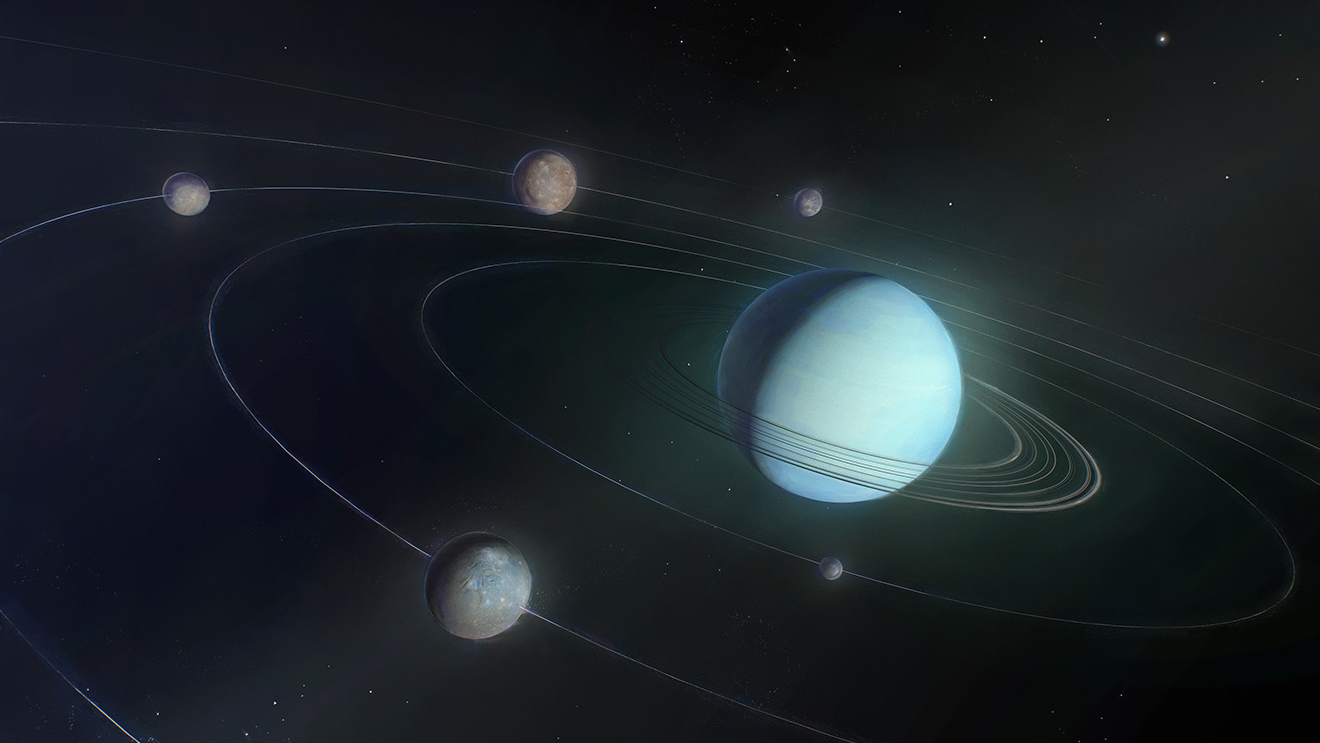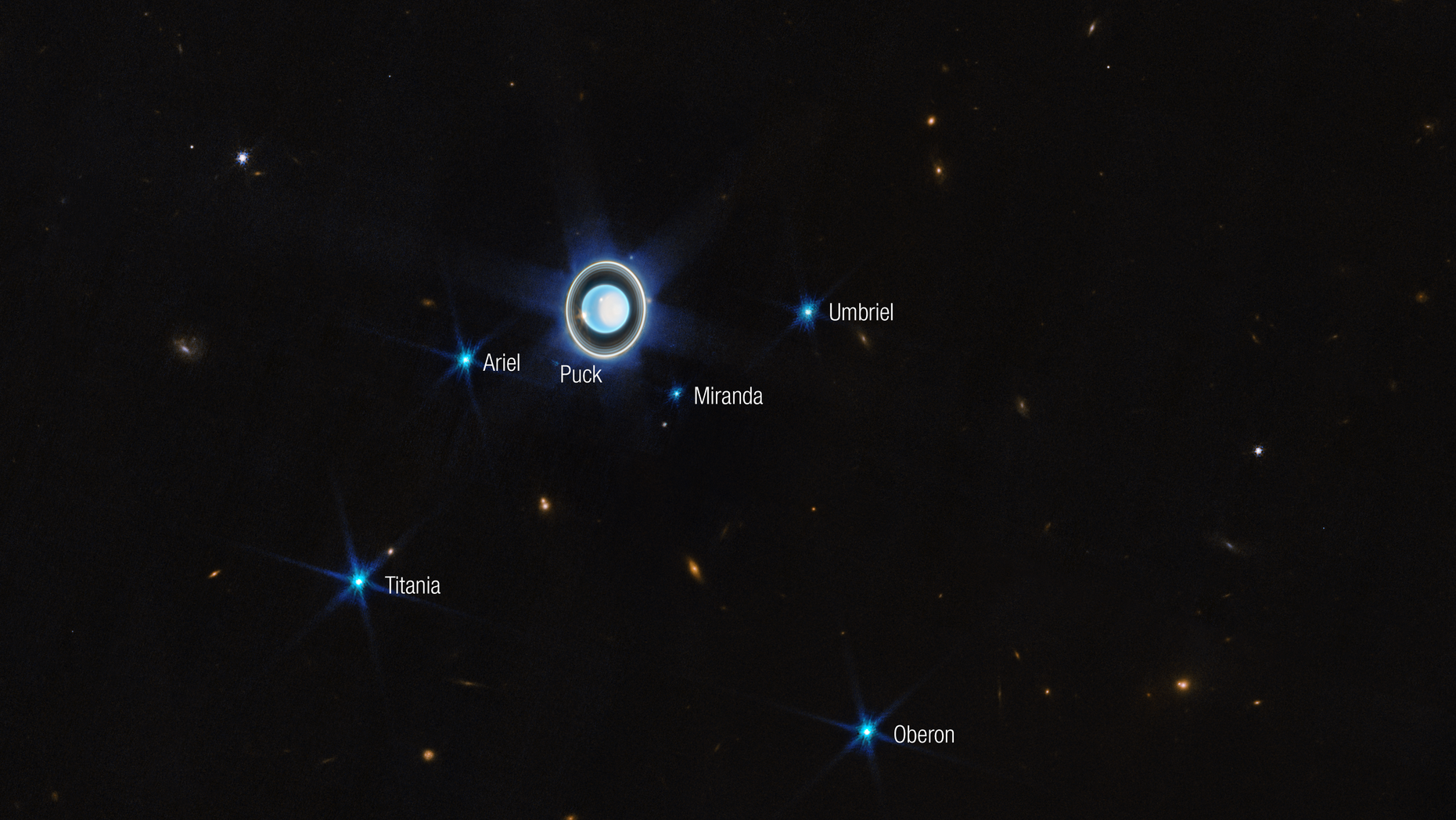
Over the last couple of years, planetary scientists have been increasingly calling for a mission to a largely unexplored region of the solar system: Uranus and its moons.
Planetary scientists know that some of Jupiter's and Saturn's moons likely possess subsurface liquid-water oceans. These "ocean worlds," such as the Jovian moon Europa and the Saturnian moon Enceladus, are not in the "Goldilocks zone" — the optimal distance from a star where liquid water can exist on a world's surface — that was previously thought to be a requirement for habitability.
Instead, researchers have been considering the possibility that life could eke out an existence inside these bodies, suspended in internal oceans heated through various mechanisms. These hypothetical life-forms might utilize chemical metabolic pathways similar to those used by life on Earth's ocean floor.
Increasingly, the astrobiology community has been looking beyond the Jupiter and Saturn systems. They're calling for a mission to Uranus and its moons, as a number of Uranus' moons have displayed telltale signs of having internal liquid oceans and chemical compositions that could be favorable to life.
Related: Extreme microbes in salty Arctic water could aid search for life on Mars
Indeed, sending a spacecraft to these far-off moons could reveal clues about their habitability and the mechanisms behind the formation and evolution of these worlds, planetary scientists explained in a recent paper.
"The most exciting prospect at the (Uranian) moons is that they could still host subsurface oceans at present. It is a low probability for some of them, so if the mission does find oceans in all/most of them, then it will help better understand what mechanisms help keep the interiors of these moons warm," says Julie Castillo-Rogez, a planetary scientist at NASA's Jet Propulsion Laboratory.
Possible internal oceans
Back in 2022, a team led by Castillo-Rogez reanalyzed data on five of Uranus' largest moons — Ariel, Umbriel, Titania, Oberon and Miranda — collected by NASA's Voyager 2 spacecraft as it flew by the Uranian system in 1986. When they combined Voyager 2's data with computer modeling that considered the radius and density of these moons, as well as potential sources of heat, the scientists found that four of the moons — Ariel, Umbriel, Titania and Oberon — could hold internal liquid oceans sandwiched between their cores and icy crust.
The Uranian system's vast distance from the sun is a significant hurdle to the persistent presence of liquid oceans inside these moons. But there's another way they could get warm enough to host subsurface oceans.
"The main source of heat for these moons comes from the decay of radioactive elements, specifically potassium, uranium and thorium," Castillo-Rogez told Space.com.

There is also geological evidence that Miranda and Ariel were subject to geologic activity — tectonics and ice volcanoes — 100 million to 1 billion years ago.
Put together, these signs suggest that Miranda and Ariel may have been subject to increased tidal heating, whereby the moons stretch and compress as a result of the gravitational interaction between Uranus and its moons.
"Miranda and Ariel are close enough to Uranus that they could benefit from more tidal heating than Umbriel, Titania and Oberon," Castillo-Rogez said. "However, because tidal heating is a function of the mass of the planet — and Uranus is seven times less massive than Saturn — we don't expect the kind of spectacular volcanism process as observed at Enceladus."
Related: Life on Enceladus? Europe eyes astrobiology mission to Saturn ocean moon
"That is, if an Enceladus-like moon was in the Uranian system, it would benefit from 50 times less heating than in the Saturnian system," she added.
Unfortunately for the Uranian moons, the same degree of tidal heating that keeps the Jovian and Saturnian moons warm just isn't possible as Uranus does not exert the same gravitational force due to its lower mass.
Assessing habitability
Every decade, the U.S. National Academies of Sciences, Engineering, and Medicine polls the planetary science community to gauge priorities for the next decade of missions. The most recent such survey, conducted in 2022, showed widespread interest in a mission to the Uranian system. But what would such a mission investigate?
One area of study would be to investigate the internal thermal conditions on the Uranian moons, which play a massive role in the functioning of life as we know it. The lower limit for growth in unicellular organisms on Earth where ice is present is around minus 4 degrees Fahrenheit (minus 20 degrees Celsius). If temperatures are too cold, the possible metabolic pathways that life could use to extract energy from its environment become much more difficult.
Known surface temperatures on the five Uranian moons of interest range from 60 Kelvin to 80 Kelvin (-213.15 degrees Celsius to -193.15 degrees Celsius), which means internal temperatures would have to be significantly warmer to be habitable.
Another important factor is salinity. If the liquid oceans are too salty, life may not be able to survive there. Researchers have been investigating how much salt microbes that live in extreme environments on Earth can tolerate, shedding light on their limits.
Access to chemical energy is another piece of the habitability puzzle. Any life on these moons would have to survive in the interior to avoid radiation and be close to the water. Therefore, these life-forms would need a steady source of chemical — rather than solar — energy. Life on Earth's ocean floor utilizes a form of chemosynthesis, in which organisms make use of energy released by inorganic chemical reactions to produce food. A similar process might be necessary for life to survive deep inside these moons.
To support life as we know it, these ocean worlds would need the building blocks of life — elements such as carbon, hydrogen, nitrogen, oxygen, phosphorus and sulfur. Conversely, toxic elements, such as arsenic, would be problematic for life.
Answers to these questions are currently out of reach, but a mission to the Uranian system would reveal clues about the potential habitability of some of these moons. Such a mission could help astronomers profile the variety of ocean worlds in our solar system and understand the processes that led to the formation and evolution of these icy oases.
"The mission to the Uranian system is not just about the moons, but is about understanding how the system (planet, rings, moons, magnetosphere) as a whole. The mission will retire many gaps in our understanding of how ice giants work, and the relationships between the moons, the planet, and the magnetosphere," says Castillo-Rogez.







